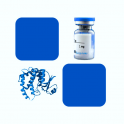
- Remove this product from my favorite's list.
- Add this product to my list of favorites.
Products
Newsletter
 |  |  |  |  |  |

Background
Cathepsin B (CTSB) also known as APP secretase (APPS) and CPSB, is an enzymatic protein belonging to the peptidase C1 family. Cathepsin B / CTSB is synthesized as a preproenzyme. Following removal of the signal peptide, the inactive proenzyme undergoes further modifications including removal of the pro region to result in the active enzyme. The catalytic activity of Cathepsin B / APPS contains: Hydrolysis of proteins with broad specificity for peptide bonds; Preferentially cleaves -Arg-Arg-|-Xaa bonds in small molecule substrates (thus differing from cathepsin L); In addition to being an endopeptidase, shows peptidyl-dipeptidase activity, liberating C-terminal dipeptides. As a thiol protease, cathepsin B / CPSB is believed to participate in intracellular degradation and turnover of proteins and has also been implicated in tumor invasion and metastasis. Overexpression of cathepsin B has been associated with esophageal adenocarcinoma and other tumors.
Source
Recombinant Human Cathepsin B, His Tag (CTB-H5222) is expressed from human 293 cells (HEK293). It contains AA Arg 18 - Ile 339 (Accession # P07858-1 (L26V)).
Predicted N-terminus: Arg 18 & Leu 80
Molecular Characterization
This protein carries a polyhistidine tag at the C-terminus.
The Human Cathepsin B will be further processed into mature form (Leu 80-Ile 339). The protein has a calculated MW of 36.7 kDa (pro-form) and 29.5 kDa (mature-form). The protein migrates as 42-50 kDa and 34 kDa under reducing (R) condition (SDS-PAGE) due to glycosylation.
Endotoxin
Less than 1.0 EU per μg by the LAL method.
Purity
>95% as determined by SDS-PAGE.
>90% as determined by SEC-MALS.
Formulation
Lyophilized from 0.22 μm filtered solution in 50 mM Tris, 150 mM NaCl, pH8.0 with trehalose as protectant.
Reconstitution
See Certificate of Analysis for details of reconstitution instruction and specific concentration.
Storage
For long term storage, the product should be stored at lyophilized state at -20°C or lower.
Please avoid repeated freeze-thaw cycles.
This product is stable after storage at:
-20°C to -70°C for 12 months in lyophilized state;
-70°C for 3 months under sterile conditions after reconstitution.
Bioactivity
Please refer to product data sheet.
(1) "The role and mechanism of inflammatory response to growing rod implantation in early onset scoliosis"
Zhang, Han, Li et al
Front Cell Dev Biol (2023) 11, 1282573
(2) "Pycard deficiency inhibits microRNA maturation and prevents neointima formation by promoting chaperone-mediated autophagic degradation of AGO2/argonaute 2 in adipose tissue"
Li, Yao, Zhao et al
Autophagy (2023)
(3) "The Role of Cysteine Protease Cathepsins B, H, C, and X/Z in Neurodegenerative Diseases and Cancer"
Stoka, Vasiljeva, Nakanishi et al
Int J Mol Sci (2023) 24 (21)
Showing 1-3 of 6848 papers.
(1) "Characterization of a novel piperidine-based inhibitor of cathepsin B-dependent bacterial toxins and viruses"
Authors: Hartmann S, et al.
Journal: ACS Infect Dis 2018
Application: CTSB activity assay
(2) "Compositions and methods for inhibiting bacterial and viral pathogens"
Authors: Martchenko M, et al.
Journal: US20160113920A1 2016
Application: NMR experiments
(3) "Identification of agents effective against multiple toxins and viruses by host-oriented cell targeting"
Authors: Zilbermintz L, et al.
Journal: Sci Rep 2015
Application: NMR experiments
Welcome Login
Contact us
Follow us